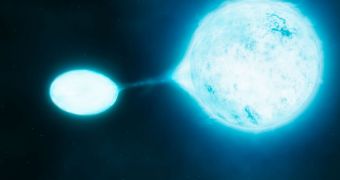Scientists have recently conducted a new survey of O-type stars, and determined that these objects, which are some of the heaviest and brightest in the Universe, are always accompanied. Very few such stars were detected that did not have a partner. Astronomers were amazed to find this weird trend.
What sets O-type stars apart from other massive stars is that they have the highest mass, the highest surface temperature, and are the heaviest stellar objects ever detected in the Universe. Unfortunately, these traits are also what causes them to be very short-lived.
By comparison, an O-type giant lives only a few hundred million years, if that, just a tiny fraction of the life span our Sun has. G-type yellow dwarfs like our star maintain their main sequence for around 10 billion years, and then go on as white dwarfs for an addition 3 billion years or so.
Previous studies have demonstrated that O-type stars are some of the most important drivers of galactic evolution. Therefore, the new study may have far-reaching implications for our understanding of the world around us.
The survey was conducted using the European Southern Observatory’s (ESO) Very Large Telescope (VLT), which is located at the La Silla Observatory, on Cerro Paranal, in Chile. Its main conclusion was that up to 75 percent of all O-type stars have companion.
Another interesting aspect of the study is that most of these binary systems display brutal interactions, where matter is channeled from one star to the other. Eventually, these reciprocal influences will lead to the two stars merging into a single, larger one.
In a paper published in the July 27 issue of the top journal Science, researchers at the University of Amsterdam, in the Netherlands, explain that the smaller companions of O-stars are more likely to draw matter from the giant objects than vice-versa.
“These stars are absolute behemoths. They have 15 or more times the mass of our Sun and can be up to a million times brighter. These stars are so hot that they shine with a brilliant blue-white light and have surface temperatures over 30,000 degrees Celsius,” UA expert and lead study author Hugues Sana says.
The expert adds that the sample the VLT surveyed contained 71 O-type stars, all of which were concentrated in 6 star clusters in the Milky Way. A large percentage of these objects interacted with each other regularly, primarily through matter exchange and tidal forces.
“The life of a star is greatly affected if it exists alongside another star. If two stars orbit very close to each other they may eventually merge. But even if they don’t, one star will often pull matter off the surface of its neighbor,” Space Telescope Science Institute expert and study coauthor Selma de Mink concludes.

 14 DAY TRIAL //
14 DAY TRIAL //